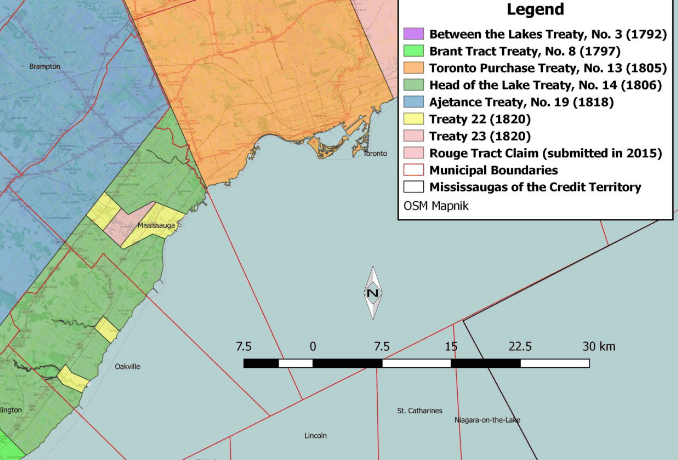Treaty Recognition Week ‘honours’ beginning of colonial ownership of Oakville
Published November 9, 2023 at 10:29 am

Oakville permanently flies the Mississaugas of the Credit First Nation flag at Town Hall to acknowledge and thank the First Nation band for being stewards of the traditional territory the town occupies.
Town Council also makes a land acknowledge before every meeting to “recognize the relationship between Indigenous peoples and their traditional territories.”
On February 28, 2022, the Town honoured the 202nd anniversary of the signing of Treaty 22 – the final event that marked the beginning of Oakville and Halton Region and the end of indigenous ownership of their lands – at a ceremony at Oakville Museum’s Erchless Estate.
The history of the events leading up to the signing of Treaty 22 and of Treaty 14, which happened a day after the Toronto Purchase Agreement in 1805, were somewhat less than honour-worthy for the Mississaugas of the Credit people.
In the Town of Oakville’s own words, the First Nation was ‘asked’ to sell lands immediately west of the land they had ceded just the day before.
A provisional agreement was reached with the Crown on August 2, 1805, in which the Mississaugas ceded 70,784 acres of land bounded by the Toronto Purchase in the east, the Brant Tract in the west and a northern boundary that ran six miles back from the shoreline of Lake Ontario.
In return for the land, the Mississaugas were to receive £1,000 worth of trade goods and the sole right of fisheries at 12 and 16 Mile Creeks along with the possession of each creek’s flats. In addition, the Mississaugas also reserved the sole right of fishing at the Credit River and were to retain a one-mile strip of land on each of its banks.
On September 5, 1806, the signing of Treaty 14 confirmed the ‘Head of the Lake Purchase’ between the Mississaugas of the Credit and the Crown, ultimately leading to the creation os modern cities and towns such as Oakville and Mississauga
A further treaty in 1818 left the Mississaugas with just three small reserves at 12 Mile Creek, 16 Mile Creek and the Credit River. William Claus, Deputy Superintendent of the Indian Department, noted the “distress and poverty” of the ancestors of the Mississaugas of the Credit people of today and proposed, as a solution to their situation, they surrender of their remaining lands.
In case that offer wasn’t sweet enough, Claus promised that the proceeds of the sale would be used to instruct the Mississaugas in the rudiments of the Christian religion and to provide education for their children.
This, by the way, was a practice largely abandoned by French missionaries in the 1690s and resurrected in 1834 when the Mohawk Institute Residential School opened its doors in nearby Brantford; opening with it a dark chapter in Canadian history called the Residential School system.
Claus (no relation to Santa) also promised a 200-acre chunk of land in the Credit River Reserve’s southeast would be set aside as a village site for the Mississaugas.
Less then two years after that, on February 28, 1820, the Mississaugas “acquiesced to the Crown,” signed Treaty 22 and ceded their lands at 12 and 16 Mile Creeks, along with northern and southern portions of the Credit River Reserve.
Treaty 23, negotiated later the same day, saw the central portion of the Credit River Reserve, along with its woods and waters, ceded to the Crown for £50.
By the end of the 17th century the Mississaugas of the Credit occupied, controlled and exercised stewardship over approximately 3.9 million acres of lands, waters, and resources in Southern Ontario. Their territory extended from the Rouge River Valley westward across to the headwaters of the Thames River, down to Long Point on Lake Erie and then followed the shoreline of Lake Erie, the Niagara River, and Lake Ontario until arriving back at the Rouge River Valley.
By 1820 they were gone from what is now Halton Region entirely.
To learn more about the deals, from both a colonial and indigenous perspective, listen to #OurOakville podcast on Indigenous History with Mississaugas of the Credit First Nation Traditional Knowledge and Land Use Coordinator Darin Wybenga; or watch a discussion between Our Kids Network Indigenous Lead Angela Bellegarde and town staff about Territorial Acknowledgement.
You can also visit the Ontario Government website to learn about the history of treaties in Ontario and review teaching and learning resources.
It’s Treaties Recognition Week in Ontario, a time to help students and residents understand the significance of treaty rights, treaty relationships and their relevance today.






